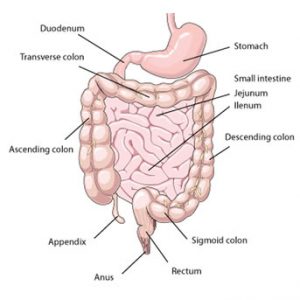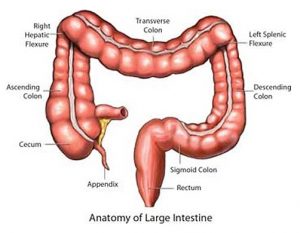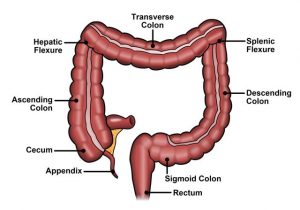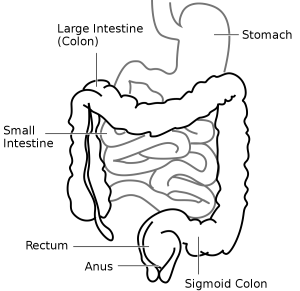What is the Sigmoid Colon?
Sigmoid colon or pelvic colon is a portion of the large intestine which is closest to the rectum and anus. It helps to flow the fecal matter from the colon to rectum and then to the anus. Feces stays in this sigmoid colon until they are in a state of elimination from the body. Before turning around 90 degrees the sigmoid colon bends toward the body’s mid part to create the rectum.
Sigmoid colon Location
This is the last portion of the colon which is curved and is S-shaped. It connects with the colon close to the iliac crest of the abdominal cavity.
How long is the sigmoid colon?
It is about 35 – 40 centimeters in length and forms a loop. This hollow tube is approx. 40 cm long and in diameter, it is around 7 cm.
Sigmoid colon Function
Its major function is to transport the fecal matters to rectum and anus. It eliminates all the solid waste and forms of gaseous waste down the gastrointestinal tract. All the body waste finds its way to get stored in the sigmoid colon until it the time when it can come out of the body through the anal canal.
Is the sigmoid colon part of the intestine?
Yes, sigmoid colon is a part of the large intestine.
Sigmoid colon Pictures
Diseases related to sigmoid colon
The most common disease to affect sigmoid colon is Diverticulitis. This disease can form in any part of the digestive system, but generally, it targets the sigmoid colon because of its position at almost the lower exterior of the body.
What is Diverticulitis?
The sigmoid colon is lined with a soft tissue which is known as the gastrointestinal mucosa. When affected by diverticulitis, these layers of soft tissue push itself through the outer layer formed of muscles thereby forming an inflammation of the intestine on the outer side. Knowing that a portion of the body present in such inner part, the muscles would be weaker – diverticulitis attacks them easily.
Causes of the disorder
There has not been discovered any particular cause of such a disorder. However, certain factors are obviously there which run the risk of getting affected by it. Following is a list of such accelerating causes:
- Lack of proper physical exercise.
- Formation of obesity in the body and a result, gaining weight.
- Any family member having attacked by this disease previously.
- Smoking.
- Intake of non-steroidal anti-inflammatory drugs.
- Sometimes, it may occur due to a reaction to some bacterial infection of the body.
Who gets most affected by its consequences?
People above the age of fifty are more prone to get affected by this disease. Also, people belonging to the Western or specifically European countries suffer more from diverticulitis than people of other countries. In rural Africa, the disease has been observed to have targeted only 1% of the entire population, whereas, in European nations, it is as high as 35%. However, as in Africa, this disease is also rarely found in Asia. In fact, previously it was quite rare all over the world but in recent years it has become common. In the year 2003, diverticulitis took the lives of approximately over 1300 people in Europe alone.
Signs and symptoms associated
There are several symptoms of this disease which you might not at once notice or consider it to be signs of such a complicated dysfunction of your sigmoid colon. But the most common is a noticeable unbearable pain on the left side of the lower abdomen. This is the most severe symptom which might worsen in a few days. The other symptoms include:
- Pain in the abdomen along with tenderness. The pain is mostly felt on the lower left side.
- Frequent vomiting tendency.
- Nausea.
- Sudden high fever.
- Constipation for a prolonged period.
- Bleeding from the rectum, the color of the blood is usually bright red.
- Diarrhea.
- Loss of usual appetite.
- Acidity or gas formation inside the body.
Further complications
The infection might spread to the outside, on the lining of the abdominal cavity. This happens in severe cases when the colon bursts open due to inflammation. The bowels can get narrowed due to the swelling up of the colon, as a result of which there is an obvious obstruction in the normal functioning of the bowel movement. Due to the inflammation, again the regular functioning of the bladder or pelvic cavity is obstructed thereby causing a fistula. The other complications that might arrive are listed below:
- Fistula.
- Bleeding from the rectum.
- Inflammation of the peritoneum or peritonitis.
- Obstruction of the bowel movement.
- Collection of pus within the inflamed portion of the colon.
- Strictures.
How to prevent yourself against this disease?
Unlike many other diseases which do not have a preventive measure, diverticulitis has. And, if maintained properly one can easily avoid such a complicated situation. Enlisted below are some of the ways:
- Smoking can easily be avoided in order to spare oneself from terrible consequences.
- Eating of food that consists high – fiber content.
- Avoid eating red meat.
- Drink plenty of water to avoid unnecessary cases of constipation.
- Exercise regularly.
How to know when to see a doctor?
Check if there’s blood in your stool or you have a nauseated tendency or vomiting. If there is an unbearable pain in the left side of your lower abdomen, at once visit the doctor. It might be caused due to any other disorder, but these symptoms being unusual should be considered seriously.
Treatment
When you visit a doctor, depending on the severity of the disease – he/she can either recommend treatment at home or under expert observation at the hospital. But the good thing is as it is in the colon it is close to the outer part of the body. So it is easier for the doctor enters a sigmoidoscope in the anus area and see. If the things are serious it also can be removed via sigmoidectomy and later the remaining part is joined with the rectum.
Home remedies
- A proper bed rest.
- Having liquid diet to rest the bowel from getting exhausted.
- Antibiotics, if the disorder is from any bacterial infection.
Treatment at the hospital
- If there has been pus formation inside the colon, doctor use syringe to drain out the pus.
- Surgery to remove the affected part.
References:
http://www.healthline.com/health/diverticulitis#treatment7
http://www.innerbody.com/image_dige08/dige47.html#full-description
https://en.wikipedia.org/wiki/Diverticulitis
https://www.theguardian.com/lifeandstyle/2011/oct/03/mapping-the-body-sigmoid-colon





I had an Endoscopy on the 11/01/18, doctors removed one 8mm Polyp, had no complications, I suffered from bleeding again. What is the reason behind it?
PS: I have a few small mouthed diverticula found in the Colon